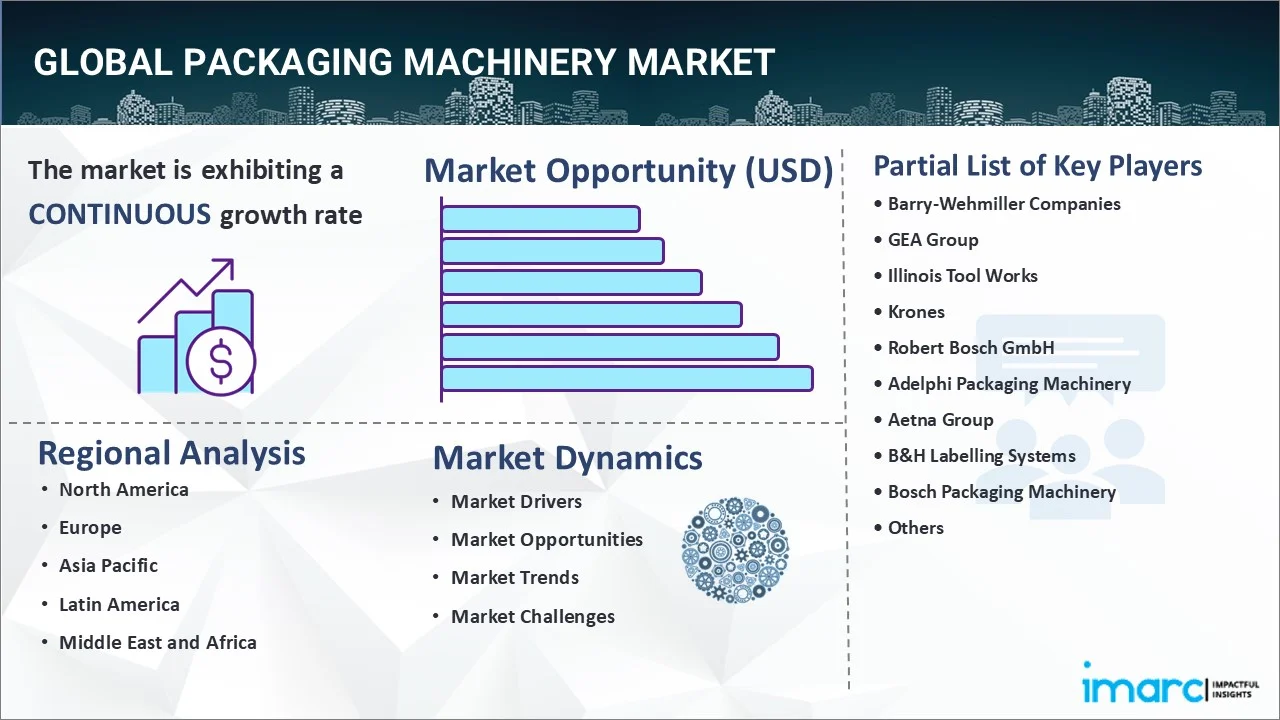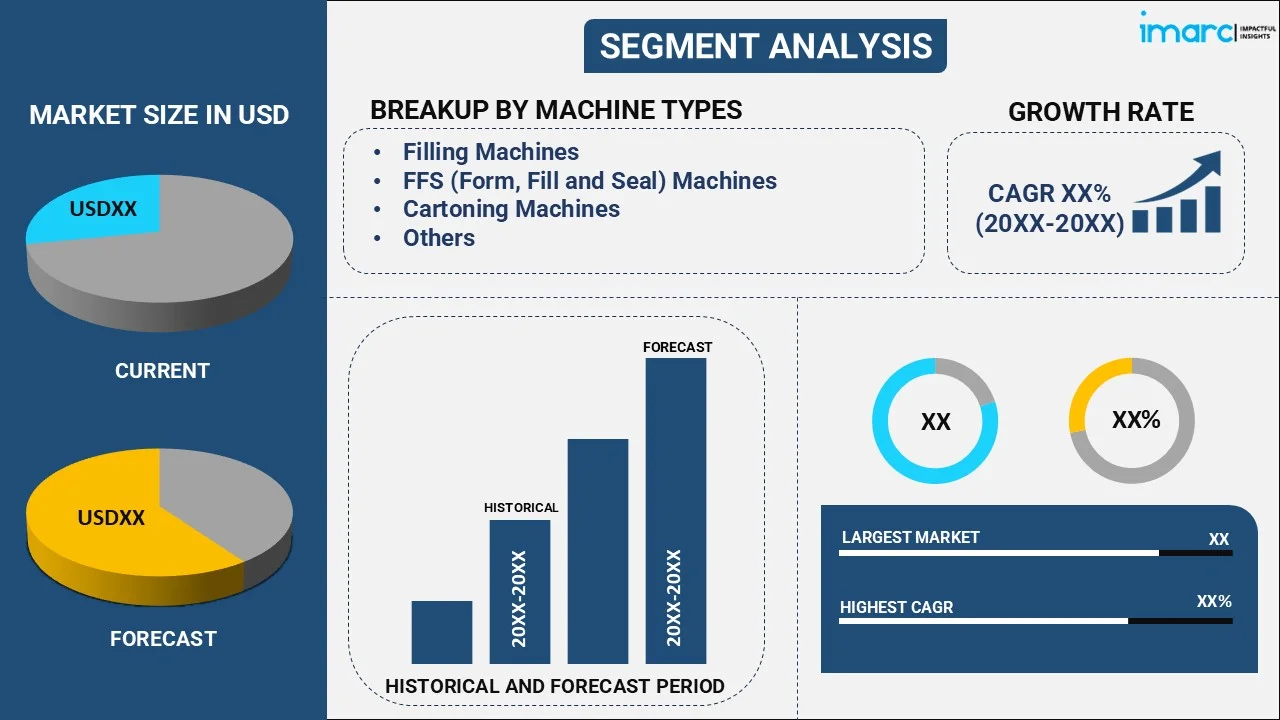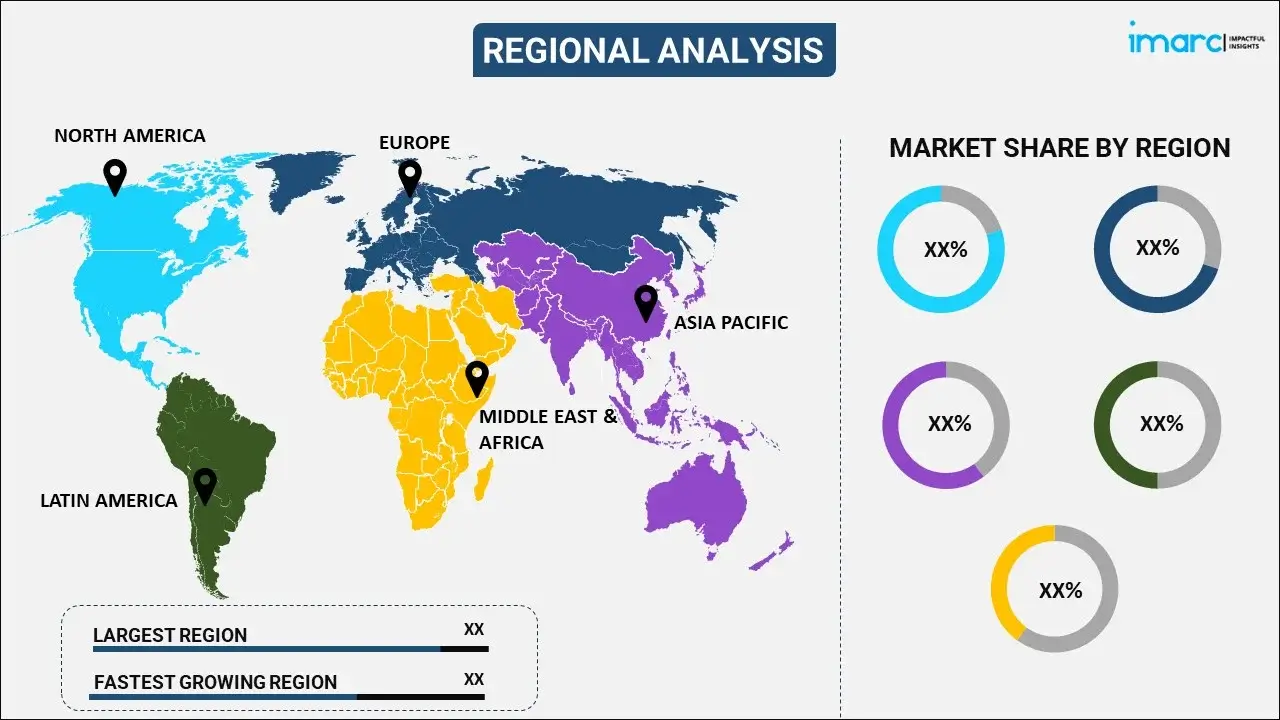
Packaging Machinery Market Report by Machine Type (Filling Machines, FFS (Form, Fill and Seal) Machines, Cartoning Machines, Palletizing Machines, Labeling Machines, Wrapping Machines, Cleaning and Sterilizing Machines, and Others), Technology (General Packaging, Modified Atmosphere Packaging, Vacuum Packaging), End-Use (Food, Beverages, Pharmaceutical and Personal Care, Chemicals, and Others), and Region 2025-2033
Market Overview:
The global packaging machinery market size reached USD 57.2 Billion in 2024. Looking forward, IMARC Group expects the market to reach USD 78.8 Billion by 2033, exhibiting a growth rate (CAGR) of 4.07% during 2025-2033. The increasing demand for packaged goods, rising number of e-commerce platforms, significant technological advancements, evolving international standards for product safety, growing focus on sustainability, and rising machinery utilization in the healthcare sector are some of the major factors propelling the market.
|
Report Attribute
|
Key Statistics
|
|---|---|
|
Base Year
|
2024 |
|
Forecast Years
|
2025-2033
|
|
Historical Years
|
2019-2024
|
| Market Size in 2024 | USD 57.2 Billion |
| Market Forecast in 2033 | USD 78.8 Billion |
| Market Growth Rate (2025-2033) |
4.07%
|
Packaging machinery refers to equipment specifically designed for the sealing, wrapping, filling, and labeling of goods in various types of packaging materials. It includes filling machines, capping machines, labeling machines, and cartoning machines, among others. Packaging machinery is widely used across diverse sectors, such as food and beverages (F&B), pharmaceuticals, cosmetics, chemicals, and consumer goods. It aids in increasing productivity, improving cost-efficiency, enhancing product safety, and extending shelf life. In addition, packaging machinery provides numerous advantages, such as labor reduction, waste minimization, greater accuracy, scalability, ease of use, and quality control.

To get more information on this market, Request Sample
The evolving international standards for product safety and environmental sustainability that are prompting manufacturers to invest in advanced machinery capable of producing compliant packaging is propelling the market growth. Additionally, rapid globalization, which necessitates standardized packaging solutions for multinational distribution, is acting as another growth-inducing factor. Furthermore, the increasing focus on sustainability is facilitating the demand for machinery compatible with eco-friendly, biodegradable packaging materials. Apart from this, the widespread machinery adoption due to changing consumer preferences towards innovative and convenient packaging designs is positively influencing the market growth. Moreover, the rising machinery utilization in the healthcare sector to produce precise and sterile packaging is favoring the market growth. Along with this, the growing machinery demand owing to the escalating competition among businesses to reduce operational costs and enhance productivity is strengthening the market growth.
Packaging Machinery Market Trends/Drivers:
The increasing demand for packaged goods
The growing demand for packaged goods, especially in the food and beverage (F&B) industry, is a dominant factor propelling the packaging machinery market. Individuals are increasingly consuming packaged food products due to lifestyle changes, urbanization, and increasing disposable incomes. These packaged products often require specialized packaging for preservation, shelf stability, and compliance with food safety regulations. In line with this, manufacturers are using a wide range of machinery that offer features, such as vacuum and modified atmosphere packaging, to extend the shelf life of products. In addition, the shifting trend toward convenience foods, such as ready-to-eat (RTE) meals and snack foods, is prompting manufacturers to seek packaging solutions that are not just efficient but also aesthetically appealing to consumers. This confluence of consumer preference and regulatory requirements is facilitating the demand for sophisticated, faster, and highly automated packaging machinery.
The rising number of e-commerce platforms
The exponential growth of e-commerce is a vital factor driving the need for efficient and robust packaging machinery. Online shopping is becoming more prevalent, which, in turn, is facilitating the demand for packaging that can protect products during shipping while also being easy to unpack. Furthermore, e-commerce often involves a diversified range of products being shipped to various destinations, which necessitates flexible and adaptable packaging solutions. In line with this, machinery that can quickly change between different types of packaging materials and sizes becomes invaluable. Additionally, automation within these machines ensures that the packaging process is quicker, more reliable, and less prone to errors. Furthermore, efficient packaging is key to reducing shipping costs, which is a significant consideration for e-commerce businesses operating on thin margins. As a result, the continued expansion of online retail is expected to fuel investments in packaging machinery that can meet the sector's unique demands.
The significant technological advancements
Technological innovations are significantly influencing the packaging machinery market. In line with this, the integration of automation technologies to enable high-speed operations, minimize manual labor, and reduce human error is propelling the market growth. Additionally, the incorporation of the Internet of Things (IoT) technology, which adds intelligent capabilities to these machines, enabling predictive maintenance, real-time monitoring, and remote control, is contributing to the market growth. Furthermore, IoT integration not only improves the efficiency of the machines but also allows for seamless connectivity within a smart factory setup, thus enhancing overall productivity. Moreover, the advent of robotics in packaging machinery is revolutionizing tasks like sorting, orienting, and placing items, thereby increasing the accuracy and efficiency of the packaging process. Along with this, innovations in machine learning (ML) and artificial intelligence (AI) are also expected to bring about next-level customizations and operational efficiencies.
Packaging Machinery Industry Segmentation:
IMARC Group provides an analysis of the key trends in each segment of the global packaging machinery market report, along with forecasts at the global and regional levels for 2025-2033. Our report has categorized the market based on machine type, technology, and end-use.
Breakup by Machine Type:

- Filling Machines
- FFS (Form, Fill and Seal) Machines
- Cartoning Machines
- Palletizing Machines
- Labeling Machines
- Wrapping Machines
- Cleaning and Sterilizing Machines
- Others
Filling machines dominates the market
The report has provided a detailed breakup and analysis of the market based on machine type. This includes filling machines, FFS (form, fill and seal) machines, cartoning machines, palletizing machines, labeling machines, wrapping machines, cleaning and sterilizing machines, and others. According to the report, filling machines represented the largest segment.
Filling machines are dominating the market owing to their versatility and critical role in the packaging process. These machines serve as the backbone of production lines across various industries, including food and beverage (F&B), pharmaceuticals, chemicals, and cosmetics. Their primary function is to efficiently fill containers, such as bottles, jars, and pouches, with precise amounts of product. Furthermore, the recent technological advancements in filling machinery, which have led to higher levels of automation, thereby increasing throughput and reducing labor costs, are fueling the market growth. Additionally, modern filling machines are equipped with sensors and control systems that allow for precise volume control, ensuring minimal wastage of products and materials. Moreover, manufacturers can easily adapt these machines to handle a variety of container shapes and products.
Breakup by Technology:
- General Packaging
- Modified Atmosphere Packaging
- Vacuum Packaging
General packaging holds the largest share in the market
A detailed breakup and analysis of the market based on technology has also been provided in the report. This includes general packaging, modified atmosphere packaging, and vacuum packaging. According to the report, general packaging represented the largest segment.
General packaging technology is dominating the market owing to its broad applicability across various industries, including food and beverage (F&B), pharmaceuticals, consumer goods, and chemicals, making it a versatile choice for manufacturers. Furthermore, it can handle a wide array of tasks such as sealing, labeling, wrapping, and filling, making it suitable for diverse packaging needs. Additionally, general packaging machinery tends to be more cost-effective in terms of initial investment and operational costs. These machines often incorporate modular designs, allowing for easier upgrades and adaptability to different packaging types and sizes. This modularity enables companies to scale their operations without the need for extensive overhauls, thus saving on capital expenditure. Moreover, they are compatible with a variety of systems and can be easily incorporated into automated lines, thus streamlining the entire production process.
Breakup by End-Use:
- Food
- Beverages
- Pharmaceutical and Personal Care
- Chemicals
- Others
Food holds the largest share in the market
A detailed breakup and analysis of the market based on end-use has also been provided in the report. This includes food, beverages, pharmaceutical and personal care, chemicals, and others. According to the report, food accounted for the largest market share.
Food is dominating the market owing to its rising consumption across the globe. This increasing demand necessitates high-speed, efficient packaging solutions to meet the growing consumption rates. Packaging machinery enables food manufacturers to increase throughput while maintaining or improving quality standards. Furthermore, the imposition of stringent food safety regulations is facilitating the machinery demand to ensure that food products are packaged in a controlled, hygienic environment. In addition, these machines often feature mechanisms for vacuum or inert gas filling to extend shelf life and preserve product quality, which is a crucial factor in meeting regulatory guidelines. Moreover, consumer preferences are evolving toward convenience and ready-to-eat (RTE) food products. This trend demands specialized packaging solutions, such as single-serve packs, resealable packaging, and microwaveable containers. Advanced packaging machinery can adapt to these varying needs, providing manufacturers with the flexibility to cater to shifting consumer preferences.
Breakup by Region:

- North America
- Asia Pacific
- Europe
- Middle East and Africa
- Latin America
Asia Pacific exhibits a clear dominance, accounting for the largest packaging machinery market share
The market research report has also provided a comprehensive analysis of all the major regional markets, which include North America, Asia Pacific, Europe, the Middle East and Africa, and Latin America. According to the report, Asia Pacific accounted for the largest market share.
The Asia-Pacific region is undergoing rapid industrialization, leading to an increase in manufacturing activities across multiple sectors, such as pharmaceuticals, food and beverage (F&B), and consumer goods. This industrial growth inherently creates a higher demand for advanced packaging solutions, thereby driving the packaging machinery market. Furthermore, the region is experiencing significant population growth, coupled with a rising middle class that has more disposable income. This shift has resulted in a heightened demand for packaged goods, further fueling the need for sophisticated packaging machinery. Additionally, Asia-Pacific countries are becoming export-centric economies, shipping goods to various parts of the world. This creates a robust demand for packaging machinery to provide efficient packaging solutions that can withstand long transportation times and varying environmental conditions.
Competitive Landscape:
Top companies are focusing on sustainability, IoT integration, and enhanced user interfaces to create advanced machinery that offers greater efficiency, automation, and customization capabilities. Additionally, several key players are engaging in mergers and acquisitions to strengthen their position and offer more comprehensive solutions to their clients. Furthermore, leading companies are developing machinery that supports sustainable packaging materials, such as bioplastics or recycled materials, to align their offerings with market demand for eco-friendly solutions. Besides this, they are expanding their operations into emerging markets by establishing local manufacturing units or distribution centers. Moreover, companies are collaborating with suppliers, distributors, and even competitors to share expertise, distribution networks, and marketing initiatives. Along with this, leading firms are offering extensive after-sales services, including maintenance, parts replacement, and ongoing support.
The report has provided a comprehensive analysis of the competitive landscape in the market. Detailed profiles of all major companies have also been provided. Some of the key players in the market include:
- Barry-Wehmiller Companies
- GEA Group
- Illinois Tool Works
- Krones
- Robert Bosch GmbH
- Adelphi Packaging Machinery
- Aetna Group
- B&H Labelling Systems
- Bosch Packaging Machinery
- Bradman Lake Group
- CKD Group
- Coesia SpA
- Fuji Machinery Company
- Harland Machine Systems Ltd.
Recent Developments:
- In May 2023, Barry-Wehmiller Companies unveiled a new facility in Minnesota, US, to develop innovative packaging machinery.
- In May 2022, GEA Group launched a new high-speed packaging system for long-cut pasta with artificial intelligence (AI) and advanced safety features.
- In November 2022, Krones acquired R+D Custom Automation LLC to expand its packaging and filling capability in the growing pharmaceutical industry.
Packaging Machinery Market Report Scope:
| Report Features | Details |
|---|---|
| Base Year of the Analysis | 2024 |
| Historical Period | 2019-2024 |
| Forecast Period | 2025-2033 |
| Units | Billion USD |
| Scope of the Report | Exploration of Historical Trends and Market Outlook, Industry Catalysts and Challenges, Segment-Wise Historical and Predictive Market Assessment:
|
| Machine Types Covered | Filling Machines, FFS (Form, Fill and Seal) Machines, Cartoning Machines, Palletizing Machines, Labeling Machines, Wrapping Machines, Cleaning and Sterilizing Machines, Others |
| Technologies Covered | General Packaging, Modified Atmosphere Packaging, Vacuum Packaging |
| End-Uses Covered | Food, Beverages, Pharmaceutical and Personal Care, Chemicals, Others |
| Regions Covered | North America, Asia Pacific, Europe, Middle East and Africa, Latin America |
| Companies Covered | Barry-Wehmiller Companies, GEA Group, Illinois Tool Works, Krones, Robert Bosch GmbH, Adelphi Packaging Machinery, Aetna Group, B&H Labelling Systems, Bosch Packaging Machinery, Bradman Lake Group, CKD Group, Coesia SpA, Fuji Machinery Company, Harland Machine Systems Ltd., etc. |
| Customization Scope | 10% Free Customization |
| Post-Sale Analyst Support | 10-12 Weeks |
| Delivery Format | PDF and Excel through Email (We can also provide the editable version of the report in PPT/Word format on special request) |
Key Benefits for Stakeholders:
- IMARC’s industry report offers a comprehensive quantitative analysis of various market segments, historical and current market trends, market forecasts, and dynamics of the packaging machinery market from 2019-2033.
- The research report provides the latest information on the market drivers, challenges, and opportunities in the global packaging machinery market.
- The study maps the leading, as well as the fastest-growing, regional markets.
- Porter's five forces analysis assist stakeholders in assessing the impact of new entrants, competitive rivalry, supplier power, buyer power, and the threat of substitution. It helps stakeholders to analyze the level of competition within the packaging machinery industry and its attractiveness.
- Competitive landscape allows stakeholders to understand their competitive environment and provides an insight into the current positions of key players in the market.
Key Questions Answered in This Report
The global packaging machinery market was valued at USD 57.2 Billion in 2024.
We expect the global packaging machinery market to exhibit a CAGR of 4.07% during 2025-2033.
The rising demand for convenient packaging solutions, along with the increasing deployment of packaging devices for automatizing various processes, including bagging, packing, bottling, etc., is primarily driving the global packaging machinery market.
The sudden outbreak of the COVID-19 pandemic has led to the growing adoption of packaging machinery solutions to protect the packaged products from biological contamination and mitigate the spread of the coronavirus infection.
Based on the machine type, the global packaging machinery market can be categorized into filling machines, FFS (Form, Fill and Seal) machines, cartoning machines, palletizing machines, labeling machines, wrapping machines, cleaning & sterilizing machines, and others. Currently, filling machines hold the majority of the total market share.
Based on the technology, the global packaging machinery market has been segmented into general packaging, modified atmosphere packaging, and vacuum packaging. Among these, general packaging currently exhibits a clear dominance in the market.
Based on the end-use, the global packaging machinery market can be bifurcated into food, beverages, pharmaceutical and personal care, chemicals, and others. Currently, the food sector accounts for largest market share.
On a regional level, the market has been classified into North America, Asia Pacific, Europe, Middle East and Africa, and Latin America, where Asia Pacific currently dominates the global market.
Some of the major players in the global packaging machinery market include Barry-Wehmiller Companies, GEA Group, Illinois Tool Works, Krones, Robert Bosch GmbH, Adelphi Packaging Machinery, Aetna Group, B&H Labelling Systems, Bosch Packaging Machinery, Bradman Lake Group, CKD Group, Coesia SpA, Fuji Machinery Company, Harland Machine Systems Ltd., etc.
Need more help?
- Speak to our experienced analysts for insights on the current market scenarios.
- Include additional segments and countries to customize the report as per your requirement.
- Gain an unparalleled competitive advantage in your domain by understanding how to utilize the report and positively impacting your operations and revenue.
- For further assistance, please connect with our analysts.
 Request Customization
Request Customization
 Speak to an Analyst
Speak to an Analyst
 Request Brochure
Request Brochure
 Inquire Before Buying
Inquire Before Buying




.webp)




.webp)












